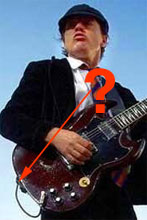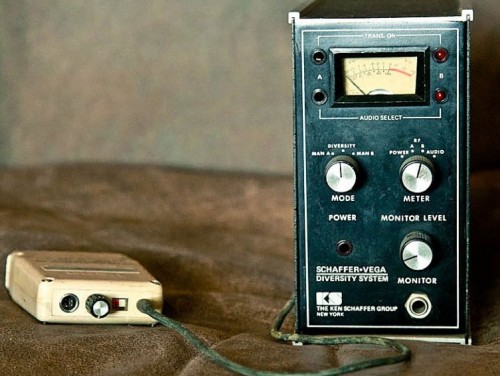Boost: Angus’ Back in Black Secret?
 These days everyone uses or knows someone who uses a boost pedal. But back in the day, it wasn’t nearly as common.
These days everyone uses or knows someone who uses a boost pedal. But back in the day, it wasn’t nearly as common.
Of course there were the Dallas Rangemaster and Horny (oops, yes I typed it that way: Hornby) Skewes Treble Booster, and a few lesser-known boxes (e.g., the Colorsound). But they didn’t seem to be widely used.
And then the MXR Micro Amp came along, and it likewise seems not to have been used that much – which is odd because it sounds good and because boosts are used all the time now.
It’s also odd because many of the classic rock folks boosted. Some was intentional, with things like tape decks (Blackmore), amp heads (Iommi) or combos. But some was unintentional, with things like the Echoplex (Page, EVH), EQs or lots of pedals on the floor.
So I guess it wouldn’t be too surprising if we found out that one of the legends of Woody Tone – a legend with a rep for just plugging straight in – used a boost. From the title of this post, you know I’m talking about Angus Young.
I happened across a thread on the killer metroamp.com forum about this. If you want to wade through the whole thing, great. But here are the highlights. Btw, this is all discovered (in this thread, anyway) by user solodallas, who if you haven’t seen him on YouTube has a huge AC/DC obsession and does some great stuff.
> Some of you may remember that I had been investigating the now-defunct Schaffer Vega Diversity wireless guitar system designed by Ken Schaffer in the late ’70s and built by “Vega” company. I was able to track down and purchase a few later units….
> There are two different types of boost on the unit: one on the rear of the unit, one on the front. In addition, it has a very good “compander” circuit (supposedly, the “Dynex” system) with a compressor and expander with adjustable settings. Basically the result is a compressor and two boosts.
> There is a description…by Ken Schaffer himself, I posted it on my site. Thing is that the transmitter (TX) has a “gain” knob on it. This, though, is not exactly a boost. It is a “sensitivity” knob, that does more than a simple boost. It also adds compression. So it’s boost and compression altogether.
> The signal gets boosted and compressed, then sent to wireless. Then the signal is received by the receiver (RX) and expanded (to remove compression). However, the expander is set to a default (tweakable!) value. So, if you really “boosted” sensitivity up high on the TX, just some compression will be removed by the RX. Some will stay.
> This is why Angus WAS indeed slightly compressed and many people thought that the recording engineers were using compression while recording. They most often weren’t: Tony Platt [AC/DC engineer] confirms this.
> Then the signal gets optionally boosted. There are two independent boosts on the RX. One is adjustable from the rear and outputs as an XLR jack. The other one is on the front panel and it says “monitor volume”, adjustable by its own knob easily. Angus had talked about a “monitor switch” from which one could boost the guitar [presumably in an interview].
> I suspect that these settings (TX, RX) have been changed slightly from song to song and album to album during the years when the Schaffer Vega was used in the studio. We know that it was used on Back in Black, at least for the solos in Highway to Hell, all of Flick of The Switch and maybe later albums up to Blow Up Your Video.
> Tonally, I am still confused to what it really adds. What I can say for sure is that with the guitar volume knob on full, there is a HUGE boost on the bass frequencies. So much that the tone becomes super fat. [For] example, the solo in “Back in Black” is exactly what you get right from the start. That is the best example sonically of what the Vega does to solos. Fat, bassy and creamy.
> I am told that the receiver has a built in power supplier that is very “strong”. Putting out a lot of volts that really choke the amplifier’s input.
> I presume now with almost arrogant certainty that this unit “defines” the missing link to Angus’ tone of the era 1977-1983 (at least, probably a bit further).
And there you have it. Thanks solodallas (more AC/DC stuff on his website), another piece of a Woody Tone puzzle.
Category: AC/DC, Wireless systems















I think you’ve hit the nail on the head with this one. Why would anyone use a wireless in the studio unless there was a benefit to it?
So glad to see you spread the word. I have further audio files on my site that prove it 100%.
thank you,
Fil
Bythe way, the original Schaffer Vega Diversity sounds different to the later Cetec Vega models. I was able to contact Mr. Schaffer in person, from whom I acquired two perfectly working units (one of them pictured above on a leather chair in San Diego, where I received them) and he confirmed. Sonically and circuit wise the units are different to the Cetec Vegas. The big, nice news is that I am now developing a replica of it. A 1:1 replica of the Schaffer Vega – which sports a compander and boost – minus the wireless transmission. AC/DC fans get ready, you WILL get THAT sound!
Fil
Great find Fil ! Any other way you might suggest using say a compressor and an eq (what freq’s what you be boosting) ? to get in the ballpark?
Sorry for the late reply Bob,
I frankly don’t know what freqs it’s boosting, as I did stop looking for the frequencies when I got the Cetec Vega – first – and my original Schaffer-Vegas, later on. We did reverse engineer the whole SVDS system (audio) however, we didn’t really boost any freqs at that point; it’s really the sum of the circuits and audio processing that happens in there that makes that unique sound that we hear. While one might think that the audio circuits were trivial in those old wireless systems, we have found that insteada they were rather intricated, and spent literally months reverse engineering everything (we used two engineers) to get it exactly right, a true clone minus the wireless. We just release our cheaper version of this unit a few days ago – it’s called the TSR Pedal, and it’s priced at 280 USD. Hope this helps you and the casual reader, Fil :-)